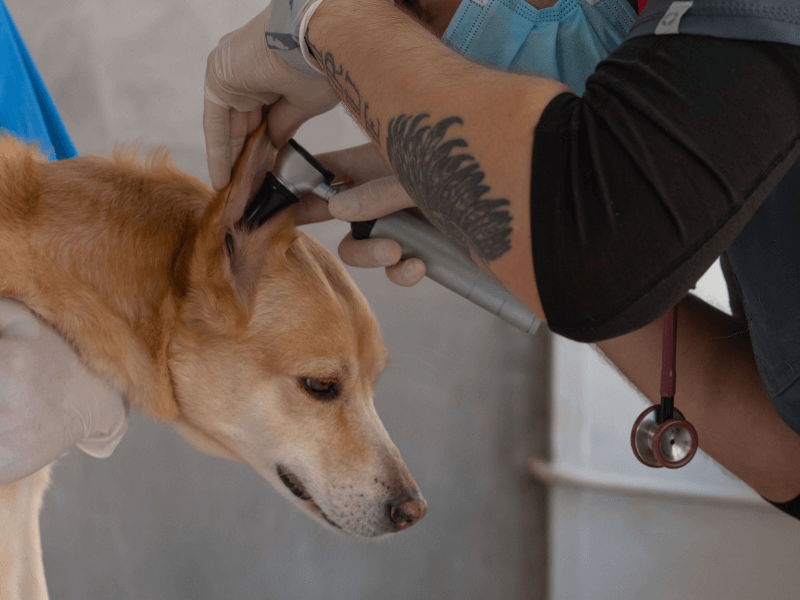Sometimes your dog may contract allergies, and it can be challenging to understand that your dog is experiencing them. Whereas humans react to allergens with sneezing, itchy and watery eyes, or congestion, dogs usually scratch, display a rash and skin inflammation, or chew on their paws.
You may have heard the term “hot spot” regarding dogs itching a spot so often there is no fur, and all that you can see is redness on their skin. Most of these allergies are caused by certain foods, fleas and other insects or pollens. However, your dog may also get these allergies from the food that it eats.
Unfortunately, these allergic issues can often develop into your dog getting an ear infection. Atopic dermatitis in dogs is an ear infection that dogs get from exposure to a previous allergen. If you don’t know about atopic dermatitis, here is what you should know as a dog owner.
WHAT IS ATOPIC DERMATITIS IN DOGS?
Canine Atopic Dermatitis (CAD) is defined as an inherited predisposition to develop allergic symptoms following exposure to an allergen. There are many breeds more susceptible to atopic dermatitis, and most show signs during ages of 1 to 3. The breeds include Irish Setters, Lhasa Apsos, Dalmatians, terriers, Golden Retrievers, and Bulldogs.
Dermatitis can occur when your dog inhales something or eats something that it may be sensitive to, such as airborne pollen or an ingredient in its food. You may notice your dog shaking a lot or scratching a lot at its skin.

WHAT ARE THE SIGNS AND SYMPTOMS OF ATOPIC DERMATITIS IN DOGS?
Depending on what is causing the allergen to your dog, the symptoms and signs can vary. They may be little to no symptoms at all, but you may take your dog to the vet and discover that there is a problem with your dog’s ears.
However, it is essential to understand that almost every case of atopic dermatitis in your dog will involve redness and itchiness. Some of the other common signs and symptoms include:
- Redness and inflammation
- Fur/Hair loss
- Frequently shaking its head
- Crusting or scaling on the edge of its ears
- Odd or noticeably different coloured stool
- Excessive scratching at ears
- Persistent chewing of the skin
- Scabs or lesions on ears
- Foul-smelling discharge from the ears
The pain from these symptoms may create a hematoma on dog's ear due to excessive scratching or shaking. Take notice if your dog is demonstrating any of these symptoms, and contact your veterinarian immediately so that you can take your dog in for a visit. Unfortunately, since the cause of atopic dermatitis can be different, there is no way to identify the root of how it develops.
OTHER TYPES OF EAR INFECTIONS IN DOGS
Atopic dermatitis is not the only kind of ear infection your dog can get. There could be other infections, including mange, fissures, mites, or another type of injury within the dog’s ear canal. Be watchful of your dog because if it is consistently rubbing and itching at the site, this could break the skin and lead to further infection.
A dog that suffers from an ear infection could have a secondary skin infection as well, so you must have your dog examined not just within the ears but all over the skin. In addition, ear infections could sometimes indicate a thyroid problem.
HOW DO DOGS GET DIAGNOSED WITH ATOPIC DERMATITIS?
When you suspect that your dog is suffering from atopic dermatitis or some other kind of ear infection, you will take your dog to the vet. The vet will then do a complete physical exam on your dog. Ensure that your vet is doing a full scope of your dog’s skin and coat. Your vet will most likely also examine your dog’s temperature, blood pressure, weight, reflex, and oxygen levels.
If you have a nervous or anxious dog, it may have to be sedated during the examination so that your veterinarian explores all areas of the skin. It is also possible the vet may need to take samples of the skin and do scrapings for testing if there are other skin lesions or scabs present to ensure there is not more than one infection to treat. They may also take urine and blood samples for the most accurate diagnosis.

TREATING ATOPIC DERMATITIS IN DOGS
If your vet comes back to you with an atopic dermatitis diagnosis, now you can develop the right treatment plan. Treatment for ear infections can be different depending on the cause or if you or your vet can identify the allergen. It would be most helpful to change your dog’s diet to treat a food allergy.
If you have not been able to locate what caused the allergy, there are still treatment options for your dog. Usually, an antihistamine injection or cortisone steroids can help. You just need to observe your dog afterward in case of any side effects from the drugs, such as increased thirst or appetite.
When your dog has a food allergy, changing to a plant-based diet can be beneficial, which your vet may suggest. Your veterinarian will also be likely to have you return for a follow-up visit to check on recovery or perform more tests to try and determine the allergen.
There are some extra things you can do at home to help ease your dog’s skin problems, such as a medicated bath or supplements to go with the medication to help soothe and calm the infected area(s). You may also want to try a natural ear cleaner to clean and refresh itchy ears. However, bringing your pet to the vet is your best method of identifying your dog’s allergy.
While identifying atopic dermatitis can be tricky, understanding your dog is key to knowing when it displays signs or symptoms of an ear infection. While you may not know what your dog is allergic to, if you sense that your dog is showing signs of an allergy, you can keep a close eye on what it comes in contact with or is eating to help you identify the root cause. Ultimately, treating your dog’s ears for atopic dermatitis will lead to a speedy and complete recovery, and your furry friend will be happy and feeling back to normal in no time!




